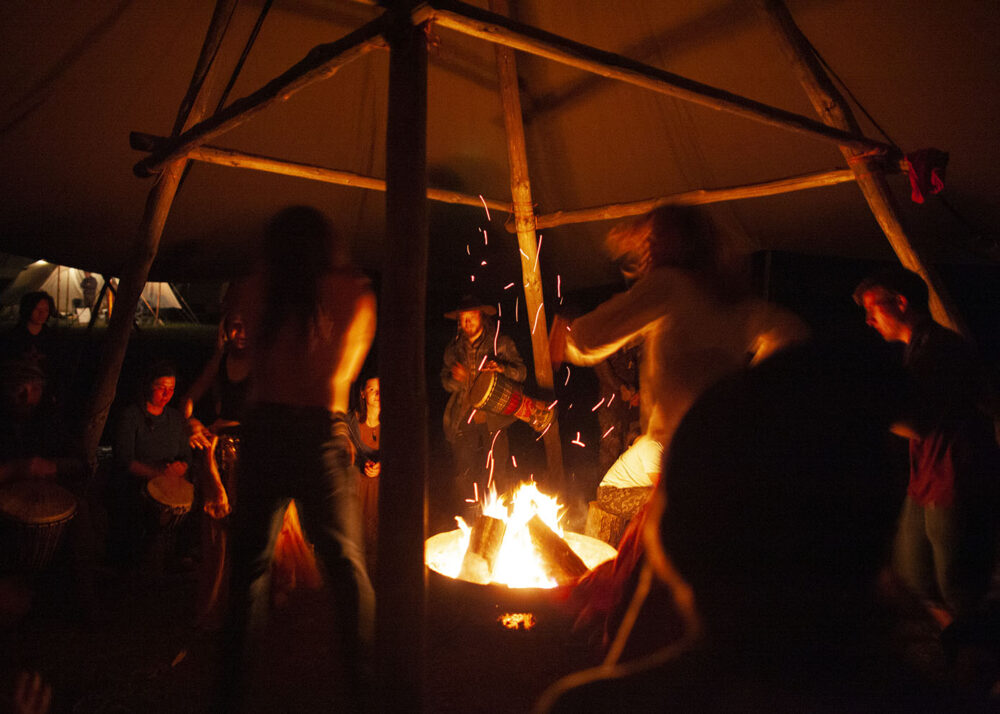Adopting a “back to nature” approach to life could offer stress reduction, stronger social connections, and improved health.
I’m standing in a forest clearing in the late afternoon, about ten miles down a dirt road outside of Grants Pass, Oregon. I’ve gathered with about a dozen other adults and teens to practice shooting arrows from longbows at bales of hay. The technology I’m using dates back at least 50,000 years and was developed by our hunter-gatherer Homo sapiens ancestors to make capturing dinner a little easier. The bow I’m holding was handmade out of Osage orange wood and deer sinew by the man who is currently staring me down, waiting for me to let the arrow fly. I’m slightly on edge, as I only get three arrows before the next archer’s turn, and I’d like to prove myself competent in this survival skill that I’ve been practicing on and off for the last four years.
Left hand loosely grips the center of the bow, right hand pulls the arrow knock back to my cheek, right eye focused on the center of the target, inhale, and shoot! Twenty meters later, the flint-knapped obsidian arrowhead pierces the hay bale, respectably close to where I intended it to go. If it had hit a deer, antelope, caribou, or wild boar, there’s a chance I could have eaten well that night. But why am I even thinking about that? What’s the point of gaining this skill when I can easily summon the delivery of a delicious beef teriyaki dinner with a few taps on my iPhone, no obsidian required?

Before I tackle that question, it’s important to know that I’m a lunatic who regularly fantasizes about throwing out the comforts of civilization and all the conveniences of modern life, running off to the woods, and reclaiming my hunter-gatherer identity—and I’m not the only one. I’m attending the Sharpening Stone gathering in 2022, one of about thirty primitive “Earth skills” events that happen across North America, Europe, and a few other countries every year. Hundreds of folks come to these events to learn skills like foraging, leather-hide tanning, stone-tool designing, and making fires by forcefully twirling a stick on a plank. For about a week, we will be turning natural materials into useful and durable goods, eating wild food communally, and sitting around the fire at night, telling stories about the stars.
Some of the attendees (you know them by their buckskin shorts, tops, and moccasins) normally live close to the Earth, but others will return to their jobs in tech, design, and education and their tight quarters in coastal cities with a renewed interest in the culture of pre-agricultural humanity. Gathering attendees set up minimal campsites and spend their days outside listening to instructors talking about Indigenous botany, animal processing, primitive pottery, and esoteric topics like how to make wood ash ink for stick and poke tattoos (ouch!).
The growing movement of human “rewilding” is not about the ancient past but the distant future.
These instructors are applying the latest findings of anthropology, archaeology, plant science, and conservation biology to the original scientific topics of humanity. For this community, anything you can’t make yourself is discouraged—it’s basically the opposite of the Consumer Electronics Show (CES), the annual Las Vegas consumer showcase to tech and excess. Stone Age enthusiasts are more interested in how humans as a species survived for nearly 300,000 years without industrial or digital technology than they are in a techno-civilized future, which they see as polluting, wasteful, counter to human evolutionary origins, and most importantly—about to collapse.
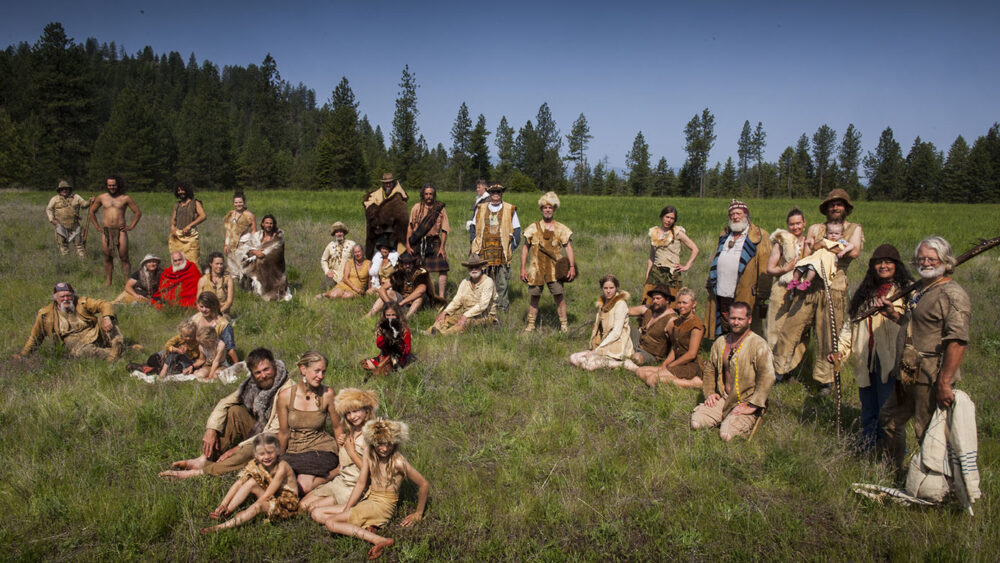
This is about the future
The growing movement of human “rewilding” is not about the ancient past but the distant future. Most of us know instinctively that being in nature is good for us, and science is proving that with more and more studies every year. Stress reduction, increased vitamin D levels, and improved mood are some of the quantifiable benefits of getting outside more regularly.
Rewilding takes things a step further. It advocates that we start re-adapting to our environment and making our lives into one long, minimalist camping trip. The rewilding mind eschews the incremental trappings of the modern environmentalist. Any effort that keeps the industrial system intact like electric cars, renewable energy, and reusable shopping bags will only put off the collapse a few years, they say. They laugh at ideas of the future involving cyborgs or billionaires conquering faraway planets. They critique geoengineering ideas like stratospheric seeding to address global warming, and they dismiss solar power as humanity’s inevitable solution, as these possibilities all rely on dwindling natural resources and present their own possible cataclysmic setbacks. Rewilders simply aren’t buying it. They see past human evolution as an extensive period of R&D, for which the hunter-gatherer lifestyle was the most successful, carrying humanity through 96 percent of our time as a species.
I’m at Sharpening Stone not only to learn more about rewilding, but also to experience how this camp, which integrates some elements of a Stone Age hunter-gatherer community, might be good for my health. This gathering was started nearly a decade ago by Adam Larue, the owner of the thirty acre property on which we are gathered. He is a survivalist and gardener who raises rabbits for meat, tends the forest, and says that his life goal is to “become wild.” Raised in a family of scientists (one brother works for Tesla, the other is a geneticist), Adam is aware of the high-tech urban life he could have led, but he finds no appeal in orienting his life around consumerism and digital progress. He prefers spending his days outside, working with the land, harvesting wild foods, and building innovative devices like a wood-burning generator—“It’s carbon neutral!” he says with delight, explaining how when the trees grow back, they recapture the carbon they released when burned.
In a tiny bit of techno-savvy irony, Larue started posting videos on YouTube to document his slow and bountiful rewilding journey. He sees his aptly named event as part of the same quest: a way for people to sharpen their skills and return to their lives renewed by nature, community, and Stone Age simplicity.
That simplicity attests to an innate love of life, or biophilia, a term coined by the famed biologist E. O. Wilson. Biophilia posits that since nature was the human environment of evolutionary adaptation for hundreds of thousands of years, it is beneficial for the human psyche. We have beneficial physiological responses to connecting with nature and living things, and we experience stress and other negative responses when we don’t get enough nature exposure. And more and more, we are not getting it, as most Americans now spend at least 92 percent of their time indoors, and two thirds of that time staring at screens.
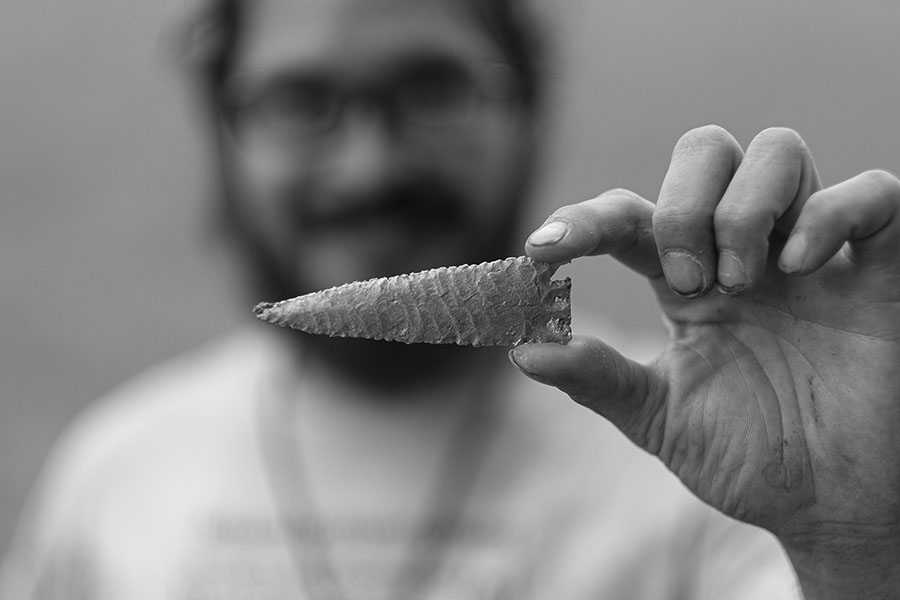
You may have heard (especially from paleo diet advocates) that your physical body is remarkably similar to those of your hunter-gatherer forebearers. It’s just that the lifestyle you have grown up with doesn’t align with who you truly are. Despite your 21st-century digital trappings, you are actually a bipedal social hominid who thrives outdoors collecting and preparing food in a tight-knit group. You evolved to range over the landscape, build simple tools and shelters, and recount your tales and dance your dreams around a collective fire. If it weren’t for your technological dependence and lack of training, you would have no trouble finding everything you need in nature. That is who you still are, yet most modern people lack the knowledge, the skills, or the physical prowess to live in the wild anymore.
You’re also different from your pre-agricultural ancestors because you experience stress more often and more pervasively, a factor of modern life we tend to downplay, but which is leading to more and more disease and death. The high stress that half of adults claim they are under is likely leading to increases in anxiety disorders, depression, insomnia, as well as the full range of metabolic ailments, from diabetes and heart disease to cancers of all kinds. The day-to-day lifestyle for nearly all modern humans has transitioned to a sedentary, indoor existence. Nearly 75 percent of Americans are overweight or obese. The rise in non-communicable diseases like all the above, which do not afflict hunter-gatherer societies living traditionally, is exacerbated, if not caused by, sub-optimal diet and exercise. There is mounting evidence that all of these lifestyle afflictions are also exacerbated by the proliferation of technology in our daily lives, and the absence of exposure to nature.
One effort to correct this deficit seeks to integrate biophilia into how we already live. Hospitals, workspaces, schools, and stores incorporating natural lighting, natural views, and soundscapes of running water and birdsong create positive benefits for workers, patients, students, and shoppers. But biophilic design can only go so far—full nature immersion, ideally for three days or more, is much more powerful medicine, although even twenty minutes, three times a week can significantly improve well-being.
Escaping civilization for a while offers relief from stress in an environment of sunlight, fresh air, diverse microbes, aromatic compounds, and calming sights and sounds that decrease cortisol levels and enhance the immune system. There are multiple benefits to our higher faculties too: increased creativity, better concentration, fewer negative thoughts, and boosted attention on important tasks. I noticed that I felt energized, excited, and free from typical neuroses while at the gathering, only to feel overwhelmed and engulfed with anxiety upon return to my hectic working life.
Folks that I met at Sharpening Stone also told me about unstudied benefits that they’ve noticed. Parents told me that their kids behaved better because they could freely run around. Myron Cretney, a sixty-something instructor who has spent his life mastering hand-tool forestry and various survival and crafting skills, advised everyone to restrict our automatic reflex to illuminate everything when walking around after dark. “Don’t blind us with your headlamp!” he cautioned. “Give it a minute, and your eyes will adjust… I invite you to experience night,” he said, explaining that so many of us never get to immerse ourselves in darkness, which was once an integral, regular human experience that triggers our natural circadian cycle of hormones, helping us relax, sleep better, regulate body fat, fight infections, and stabilize blood pressure.
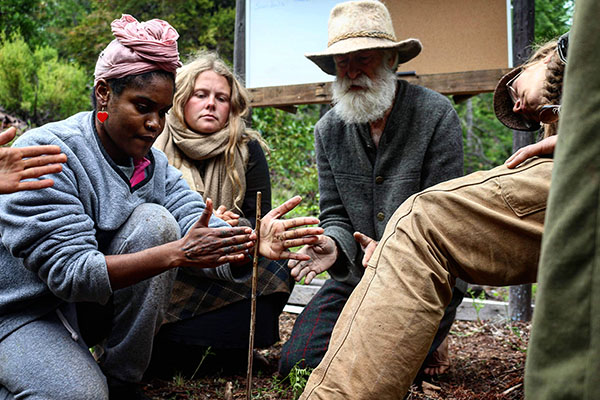
But for many of us moderns, nature immersion also comes at a cost—less comfort. Maybe you’ll sleep on a rigid surface, deal with bug bites, prickly plants, the seasonal hazards of scorching sun, mud and rain, snow or ice, and exist in a general state of grime and sweat (which, incidentally, actually restores beneficial bacteria to your skin). We have quickly, in just about one hundred years or less, managed to all but eliminate outdoor discomforts from daily life. We manicure our lawns, spray for bugs, filter our air, sanitize our houses, shower every day, and sleep on pillow-top mattresses. Yet for most of our species’ history, people experienced the positive effects that come from managing all that discomfort. They were physically and mentally stronger, as well as more grateful and content with the comforts they could achieve.
This is also true for the several remaining human groups that still rely on hunting and gathering for their daily needs. For instance, the Tsimane people of Bolivia, whose health has been extensively monitored over the past twenty years by anthropological researchers, show the best heart health in the world, low rates of chronic disease and dementia, and high rates of physical activity. They catch or grow all of their food and spend six to eight hours a day outside being active, and they are not exposed to any urban or agricultural pollutants.
With the developed muscles and strong bones similar to Olympic athletes, wild people present and past demonstrate enduring physical prowess. Those of us living in the digital age are in many ways still Pleistocene people, though the past generations of technological development have decreased our strength, bone density, and the acuity of our senses. Some scholars have even posited that these changes mean that those of us who no longer live wild have become genetically domesticated, just like our pets and farm animals. According to this idea, continuous selection for less-aggressive mates over tens of thousands of years has led to humans exhibiting similar bodily traits as other domestic mammals, (increased cooperativeness, smaller teeth, jaws, and facial bones, and fewer neural crest stem cells), known as the domestication syndrome. There are also other observations that point to decreased robusticity in our species that don’t have a genetic component.
Take one measurement—grip strength—which is a key predictor of overall health. According to one study, our collective handshake pressure has dramatically decreased, just in one generation. Research published in the Journal of Hand Therapy measured the grip and pinch strength of 237 healthy men and women between the ages of 20 and 34. Compared to strength scores from a similar study thirty years before, the modern-day study subjects appeared to be weaker, and significantly so for the men. Today’s 20- to 34-year-old man is able to apply 98 pounds of force when gripping with his right hand, but similar men gripped with 117 pounds of force in 1985. While this study is perhaps worth questioning because the sample size was relatively small, other studies have conclusively documented the dramatic decrease in general fitness and bone strength since the dawn of agriculture.
One might argue that we don’t really need grip strength so much with our current lifestyles; our hands are mostly occupied with tasks like tying shoes, doing up buttons, and tapping the keyboard. People today are more likely to swipe a screen than skin a squirrel. Yet we still face existential threats that might require superior athletic ability to evade—threats that may become more common and deadly with climate change, as is evidenced in recent summers by the folks who get trapped by extreme heat, wildfires, floods, and other disasters, unable to run, swim, or climb to safety.
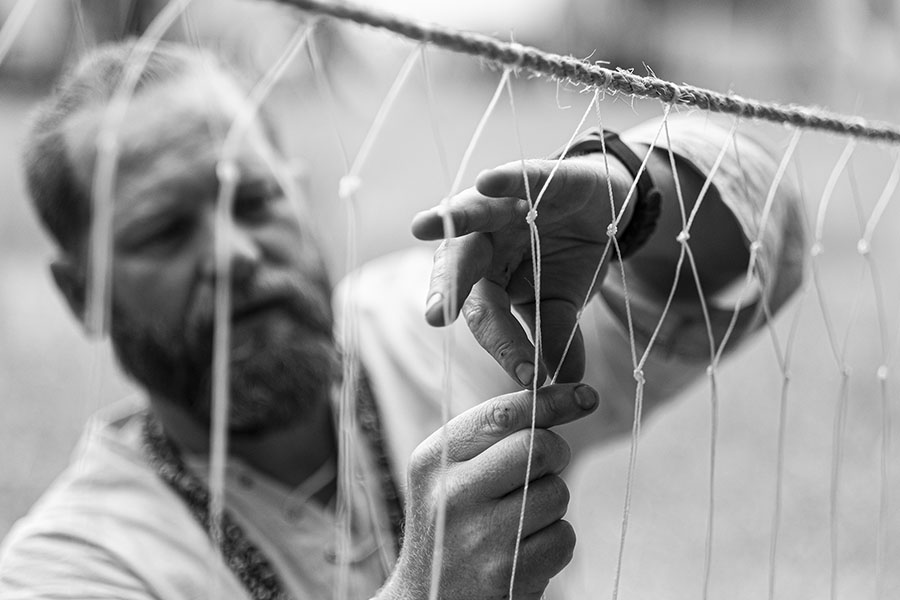
Could we civilized folks, for example, run barefoot to escape a tsunami? That’s exactly what the native Andaman and Nicobar islanders did, when they tracked the movement of wind, sea, and birds to flee the shores where they were fishing, in time to escape the brunt of the giant waves that devastated the area in the tragic and deadly 2004 Indian Ocean tsunami. Incidentally, scientists mark a decline in overall robusticity in populations that have become sedentary, while these Andaman islanders, whose physically demanding lifestyles mean that they get around fourteen times as much movement daily as the typical American, were found to have experienced no decline in any biomarkers of strength.
The movement that these foragers engage in is integrated into daily tasks such that there is no separation between work, exercise, socialization, and rest—it’s all just life. However, for the typical white-collar desk worker, most human movement has been outsourced to other workers who farm, harvest, manufacture, transport, sell, and deliver the goods they order from phones. In this context, exercise has become an optional activity that often requires concerted effort to achieve, which is why one in four people worldwide just don’t get any physical activity at all. It’s a lifestyle choice as opposed to a necessity of life.
By contrast, my days at Sharpening Stone required manually constructing and maintaining my shelter, transporting water and firewood, and toting around all of my supplies from activity to activity across varied terrain. We even worked in some butchering, digging, and harvesting wild plants—all of which require arm and hand strength and a range of motion and repetition that would even be hard to achieve in a yoga or Pilates class. Plus, everything we were doing had a tangible survival use, required no extra energy inputs, and burned no fossil fuel. At one demonstration, I learned to retrain my posture (chin up, shoulders back, tailbone out) to make all of these activities more comfortable. In addition to everything else humans lost when we succumbed to sedentary lifestyles, our slouching, slumping, and drooping in cushy furniture has led to an epidemic of back and neck pain and a decrease in the strength of every muscle that attaches to the spine.
| 7 Tips for Stone Age Living |
|---|
| Embrace the dark. Don’t use any lighted devices at night (or any devices at all) and rely on the sunrise and sunset to determine when you wake and sleep. |
| Eat dandelion greens. These highly nutritious leaves, recognizable to almost everyone, contain more nutrients than kale, and can be easily tossed into a salad or soup. |
| Use natural tools. Before taking out a tool, see if there are natural materials around: Sharp rocks can cut, sandstone can grind, fresh leaves can wipe up, and pine branches can scrub. |
| Sit on the ground. Leave the camping chairs at home and sit or squat on rocks, stumps, and the ground to rest. This helps strengthen postural muscles that are underused. |
| Wander off the trail. Walking on uneven ground, climbing, crawling, and jumping through natural environments provides a workout that’s stimulating to your body and brain. |
| Walk barefoot. Putting your bare feet on grass, sand, mud, and rocks provides all sorts of sensory inputs and stimulates the foot’s pressure points. |
| Look up at the sky. Gaze up at the sky or across the horizon and let your eyes see the infinite. We spend too much time straining our eyes to look at things up close, like screens or the walls. |
Wild carrots and stinging nettles
During my rewilding week, I joined a small group to study the variety of edible greens that were arrayed in a mosaic across the forest floor. With a native plant botanist leading us around, we sampled yerba buena, the herb that the original settlement of San Francisco was named for. We dug up onion-like bulbs of camas, pulled out wild carrots, and carefully gathered the highly nutritious leaves of stinging nettle. Food was all around us, once we knew what to look for. These weren’t just filler calories, either. Across the board, foods grown in the wild, without any additives or human tending, typically contain more nutrients and essential trance minerals than the produce available at grocery stores—even the organic stuff.
This is because cultivated fruits and vegetables have, for many centuries, been selected for their size, hardiness, transportability, and long shelf life. Studies show that as a result of this breeding and monoculture selection process, common types of produce have lost much of their nutritional value. While many wild foods are on the menu at high-end restaurants (chanterelles and lobster, anyone?), the truth is that some of the healthiest foods are available for free, and many of them are growing in our backyards, road medians, and public parks as weeds. Peter Michael Bauer, the director of Rewild Portland, which offers classes and camps teaching adults and kids to forage and craft with wild materials, says that rather than weeding our gardens, we should consider that same activity harvesting, since “almost every plant has an edible or medicinal quality,” he says.
People living in small towns and villages are generally happier than those living in cities.
As a result of venturing out with various plant experts, I now feel confident in my plant foraging abilities and am always looking for edibles anytime I’m outside. But I was also tipped off to another staple aspect of our identity as social primates. It’s immensely enjoyable to be among small groups of familiar faces every day, similar to the small clans that our species evolved in over millions of years. A significant body of research reveals that strong social networks are the key to well-being, and humans still tend to prefer our original hunter-gatherer group sizes of about 12–25 individuals. People living in small towns and villages are generally happier than those living in cities. Case in point, a recent study at Harvard showed that New York is the unhappiest of all American cities—318 out of 318.
Over the past several years as I’ve gone to dozens of these Stone Age skills gatherings and hung out with rewilders, I started incorporating many of their practices into my life, reducing my indoor and screen time, and boosting my face-to-face time in the community. As a result, I’ve reaped the benefits of increased fitness, physical competence, the ability to survive in the wilderness, more connection to nature, and a better understanding of how human societies functioned before the rise of civilization roughly 10,000 years ago. Apocalypse? Bring it!
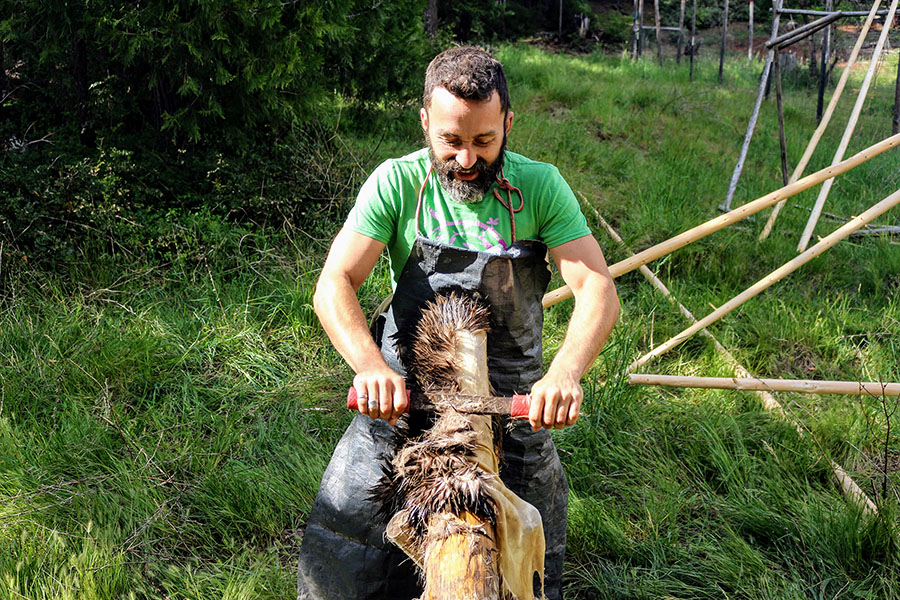
A bigger lesson has emerged, though. By gaining these skills, I am no longer fearful of what I might encounter in nature. Self-sufficiency breeds courage and resilience, qualities that wild humans develop in abundance. Understanding that our birthright is a fearless, happy, low-stress, and socially supported way of life provides a reassuring baseline. In light of the last two years of COVID-19 fear and isolation, what’s become apparent to me is that humanity cannot lose the skills of living wild, even as the industrialized global North ascends further and further up the ladder of technological progress.
Not everyone will be interested in learning how to bow hunt or tan a hide. But because the world’s Indigenous populations are under threat from increasing development and assimilation into dominant global culture, fewer and fewer people retain the knowledge and skills that would allow humanity to thrive in the event of total collapse of our supply chains and industrial manufacturing systems—not to mention governments, infrastructure, and civil society. Even some mainstream scientists are now considering the possibility of a hunter-gatherer future for humanity if the worst predictions of climate change manifest and civilization as we know it begins to break down.
While this possibility leaves most of us in shock and grief, some individuals and small collectives are already preparing for a radically different future outside of industrial life. From their perspective, there is only one viable direction for humans to take in response to overpopulation, peak resources, and climate change: We need to rewild and build a self-sufficient, nature-embedded culture. They’re willing to give up every comfort and convenience to fall back on the original human lifestyle.
This won’t be appealing to most folks, regardless of whether these predictions come true. It would be hard for us to give up things like coffee, AC, and internet unless we are forced to, and abandoning our centuries-old dream of technological progress sounds positively heretical. But for some—the rewilding curious or Stone Age adjacent—even experimenting with some primitive technology on a camping trip can certainly help you feel more competent in the wild.
